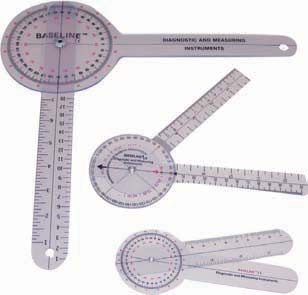Goniometers

Injury to a limb (upper or lower extremity) or the trauma of a surgical procedure to correct an injury is always marked by a reduction in the strength of the muscles and a loss of range of motion (ROM) at the affected joint(s). As such, the ultimate goal of rehabilitation for these and other musculoskeletal injuries is to restore muscle strength and joint range of motion to pre-injury levels.
Establishing a baseline joint ROM in degrees for comparison to norms and from which to measure progress is essential in evaluating the effectiveness of therapeutic interventions. Goniometers are specialized instruments used to measure angles at joints and is derived from two Greek words, gonia, meaning angle, and metron, meaning measure. In musculoskeletal evaluation, a goniometer measures the change in relationship between the bones that form a joint, presenting the available range of motion at a joint.
Types and Parts of a Goniometer Used in Physical Therapy
There are different types and sizes of goniometers. Larger and midsize goniometers are used to measure degrees of range of motion at the larger joints like the shoulder, elbow, hip, knee, and even spinal measurements. Smaller goniometers are for measurements at smaller joints like the wrist and ankle. Then there are goniometers made specifically to measure the smallest joints of the fingers and thumb. Goniometers are usually constructed of plastic or metal. Each of these different types of goniometers have the same basic components.
- Body: designed like a protractor but is oval in appearance with a measuring scale of 0° to 360° circularly located around the body. An axis or fulcrum is in the center of the body and is placed over the joint to be measured or an associated body landmark.
- Stationary Arm: this is the arm that extends from the body and is placed parallel to the stationary or proximal bone (or body part) that forms the joint that is being measured.
- Moveable/Mobile Arm: this arm is aligned, using a specified body landmark, with the moveable body segment/bone (distal segment of a joint).
Reading a Goniometer
- When measuring a joint where the measurement starts at 0°, like the elbow joint, follow the black line that starts at 0° and read the BLACK number.
- When measuring a joint where the measurement starts at 90°, like the ankle joint, follow the black line that starts at 90° and read the outer RED number.
Shop ProhealthcareProducts.com for a variety of goniometers from industry leaders in musculoskeletal assessment like Baseline and Lafayette.
If you have any questions or would like a recommendation please reach out to customer service or request a quote.




